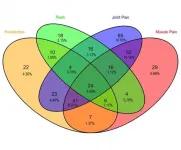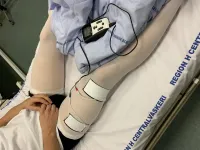(Press-News.org) Singapore University of Technology and Design (SUTD) researchers have uncovered how the environment can impact highly sensitive quantum behaviours like localisation. Their findings, published in Chaos, could lead to future innovations in the design of superconducting materials and quantum devices, including super precise sensors.
Quantum technology, in particular quantum sensing, promises to measure and capture our world at levels of precision never before possible. Such precision has diverse applications, from speedier and more sensitive medical imaging to recording time on high-frequency market trades, and even the development of sensors that can determine whether the ground beneath us is solid rock or a natural oil-and-gas reservoir.
Yet for all its theoretical potential, one considerable practical challenge remains when producing quantum measuring devices: controlling how they respond to the environment. Real devices are extremely sensitive to noise, which at best reduces their level of precision and at worst leads to unacceptable levels of error. When it comes to crafting ultra-precise sensors, such noise could overwhelm any useful signals.
Understanding how quantum devices respond to noise would help researchers find new ways to protect them from noise, making novel measurement and sensing technologies more feasible. Beyond increasing their accuracy, researchers may even be able to give quantum devices new properties. "If you could tune the amount of noise that these devices experience, you can make them function very differently and get an even more interesting device," explained Associate Professor Dario Poletti from SUTD, who led the study.
For example, scientists have known for decades that disorder in a system can cause a phenomenon called localisation, where a system gets 'stuck' to its initial state. On the other hand, when the particles in a system interact with each other strongly, there is a possibility that they can become 'unstuck,' that is, delocalised.
To study this tug-of-war between disorder and interaction, Poletti and PhD student Xiansong Xu added a third variable: the environment. Beginning with a theoretical model known as the XXZ spin chain, the researchers showed that the environment can have contrasting effects on localisation, depending on the strength of both the disorder and interaction in the system.
Performing numerical computations on the model, the researchers found that putting the system in contact with a dissipative environment such as a bath of photons pushed it towards delocalisation and made it more mobile, fluid and uniform, like water.
Importantly, they also found that while both weakly and strongly interacting systems still showed signs of localisation, the types of localisation were surprisingly different: one grainier and stuck, like sand, and the other, more uniform while still stuck, like ice.
This theoretical discovery suggests that the properties of certain materials can be tuned through changes in the external environment. For example, researchers might be able to turn a material from an insulator into a conductor by shining light on it -- or turn the material from one kind of insulator into another, with applications that go beyond quantum technologies to materials science and nanoelectronics.
"There are already quantum devices out there, and we will likely see more and more of them," Poletti said. "Devices are never truly isolated from their environments, so we would like to better understand how they can work in conjunction with the environment."
"Now the quest is to dig deeper and look for different systems, or go towards real materials and see what else can happen there," he added. "This kind of research is done over many years. We're trying to build fundamental knowledge and tools so that eventually, industry can take over."
INFORMATION:
In the Philippines, in the early months of the COVID-19 pandemic, there occurred a supply shortage of hydroxychloroquine and methotrexate. Limited access to medication and the life changes caused from the COVID-19 pandemic may prompt patients with rheumatoid arthritis (RA) or systemic lupus erythematosus (SLE) to experience disease flares.
The researchers investigated self-reported symptoms of disease flares among patients with rheumatoid arthritis or systemic lupus erythematosus during the COVID-19 pandemic. They collected information through online surveys from 512 patients with SLE or RA. The data included ...
The Montreal Heart Institute (MHI) announces that the COLCORONA study results are published today in The Lancet Respiratory Medicine. The article, which is entitled Colchicine for community-treated patients with COVID-19 (COLCORONA): a phase 3, randomised, double-blinded, adaptive, placebo-controlled, multicentre trial, concludes that, given the lack of oral therapies available to prevent COVID-19 complications among non-hospitalized patients and the observed benefit of colchicine in patients with a PCR-confirmed diagnosis of COVID-19, this anti-inflammatory drug could be considered as a treatment for those at risk of ...
Multiple scientific studies show switching completely to vaping with high-quality products has reduced health risks compared to smoking, contrary to many consumer beliefs
Study data indicates that vaping products can provide an alternative for smokers who would not otherwise quit
Review supports the important role for vaping products in Tobacco Harm Reduction
Reinforces the importance of BAT's unique consumer-centric model and how we are reducing the health impact of our business and building A Better Tomorrow™ through our multicategory approach
To mark World Vape Day, BAT has today published a comprehensive review of the scientific evidence ...
In a world first, scientists from the University of Sussex have recorded blood oxygen levels in the hippocampus and provided experimental proof for why the area, commonly referred to as 'the brain's memory centre', is vulnerable to damage and degeneration, a precursor to Alzheimer's disease.
To understand why this region is so sensitive, the University of Sussex researchers, headed up by Dr Catherine Hall from the School of Psychology and Sussex Neuroscience, studied brain activity and blood flow in the hippocampus of mice. The researchers then used simulations to predict that the amount of oxygen supplied to hippocampal neurons furthest from blood vessels is only just enough for the cells to keep working normally.
Dr Catherine ...
The basis for this new take on the classification was laid in 1985, when John Long attributed a fossil tooth plate to a new species, Edaphodon eyrensis. The species was named after Lake Eyre, near which the tooth was found in 1978.
Asscoiate Professor Evgeny Popov had his doubts about the attribution. However, he had to study the fossil personally to advance his theory. The opportunity presented itself during a trip to Australia in 2010. The tooth plate was stored in a museum in Adelaide, South Australia.
"I didn't plan to go there, but I was able to negotiate a temporary ...
A research group from Aarhus University has developed a special biocompatible electrode for electrical muscle stimulation that the group has integrated and 3D-printed onto medical support stockings.
In the winter 2020/2021, the stockings were tested on hospitalised Covid patients. The studies were completed in March, but apart from a case study (Danish Medical Journal) data have not yet been published. However, the project group reveal that the results are very promising.
The stockings were tested on 16 Covid-19 patients who agreed to try the support stocking during their hospitalisation. The participants were hospitalised for five to seven days and were given a support stocking on each leg, but only ...
The countries around the Baltic Sea do not respect their binding international agreement to reduce agricultural pollution of the marine environment. Despite farming activities being the single most important source of nutrient pollution to the Baltic Sea.
An international research team presents evidence on these circumstances in a recent scientific article in the journal Ambio, published by the Royal Swedish Academy of Sciences.
The countries made a commitment 20 years ago to implement 10 specific reduction measures in their national legislation on agricultural pollution - e.g. featuring minimum storage capacity for manure and regulations on animal densities.
Now the researchers' study of legislations and regulations in place at national level, to address ...
AMES, Iowa - Researchers have developed new types of materials that combines two or three types of nanoparticles into structures that display fundamental new properties such as superfluorescence.
"The whole goal of this research is to make new materials with new properties and/or exotic new structures," said Alex Travesset, an Iowa State University professor of physics and astronomy and an associate scientist for the U.S. Department of Energy's Ames Laboratory. "Those materials are made of very tiny materials, nanoparticles, and lead to properties not shared by more traditional materials made of atoms and molecules."
In this case, an international research team is combining perovskite nanocubes - tiny crystals with useful electrical or optical properties ...
Metal-organic framework compounds (MOFs) consist of inorganic and organic groups and are characterised by a large number of pores into which other molecules can be incorporated. MOFs are therefore interesting for many applications, for example for the storage of gases, but also for substance separation, sensor technology or catalysis. Some of these MOF structures react to different guest molecules by changing their structures. They are thus considered switchable.
One of these is "DUT-8", a material that has now been studied at the MX beamlines of BESSY II. "MOF crystals can be analysed very well at the MX beamlines," says HZB expert Dr. Manfred Weiss, who heads the MX team. ...
A breast cancer therapy that requires just one shot of radiotherapy is as effective as traditional radiotherapy, and avoids potential damage to nearby organs, according to a paper by UCL experts.
The results, published in the British Journal of Cancer, mean that eight out of ten patients who receive the treatment, TARGIT-IORT, will not need a long course of post-operative external beam radiotherapy (EBRT). These results strengthen and expand previously published outcomes.
Patients who received the treatment are less likely to go on to experience fatal cardiovascular disease such as heart attacks, lung problems or other cancers. As well as avoiding scattered radiation from EBRT that can damage nearby vital organs, delivering TARGIT-IORT during the lumpectomy procedure seems to ...


